
The 12 Best Cherry Blossom Spots In Hiroshima
With its delicious local cuisine and wealth of sightseeing spots, Hiroshima is visited by many sightseers throughout the year. Cherry blossom season, around early April, is one of the most stunning times to visit. We've rounded up the twelve best places to see cherry blossoms in Hiroshima. Read on to plan the perfect trip to this gorgeous area of Japan!
This post may contain affiliate links. If you buy through them, we may earn a commission at no additional cost to you.
1. Peace Memorial Park, Hiroshima
Hiroshima's Peace Memorial Park is an area visited year around by many people. It's a large park with about 300 Yoshino variety cherry trees, making it one of the best spots in Hiroshima for cherry blossoms. You can enjoy taking a ride on the water taxi or a pleasure cruise here, giving you a unique chance to see the blossoms on the water.
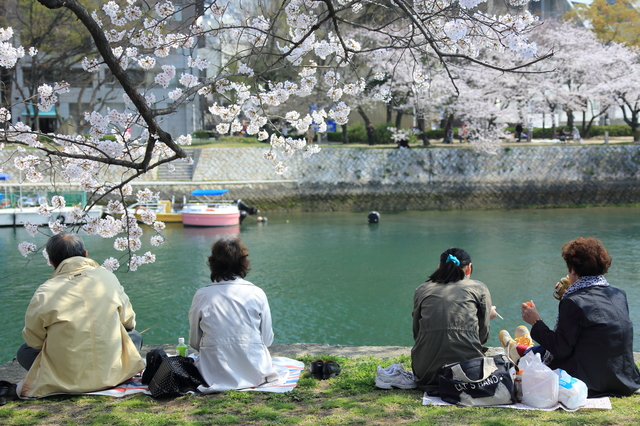
This leisurely cherry blossom park is surrounded by the Ota and Yasuda Rivers. You can enjoy the cherry blossoms as you take a walk around the park seeing the sights, too. Since it's a famous sightseeing area, it's easily accessible and is a great place for your very first hanami (flower viewing) picnic.
Peak cherry blossom season: Late March to early April
About Peace Memorial Park
Opening hours: 24 hours
Closed: Never
Price: Free
Access: 5 minute walk from Genbaku Dome-mae Station
Address: Nakajimacho 1, Naka-ku, Hiroshima-ku, Hiroshima (Google Map)
Website (Japanese): www.hiroshima-navi.or.jp/sightseeing/shizen_koen/koen/4723.php
2. Hiroshima Botanical Garden, Hiroshima
Hiroshima Botanical Gardens is a verdant area in the western part of Hiroshima's city center. This garden has a lookout spot where you can see the Seto Inland Sea. As expected from a botanical garden, there around 300 sakura trees of about 70 varieties that you can enjoy between late March and early May here. Within the wide grounds, is also a large greenhouse, a cactus green house, a flower evolution garden, and other facilities. There is about 200,000 kinds of plants of 10,000 varieties growing here, so it's an unmissable spot for anyone with an interest in gardens and botany.
During the annual Sakura Matsuri festival and the Sakura to Hikari no Yuube event, the grounds are lit up between 4:30 pm 9:00 pm, creating an enchanting springtime atmosphere.
The most famous part of the Sakura Matsuri is the Bonbori no Yaezakura Meiro. Yaezakura are double-flowered sakura trees, and bonbori are paper lanterns. They're put together to create a maze that envelopes visitors in warm light. Various events are held during the festival and special food stand ssell all kinds of cuisine to enjoy as you take in the sights.
Peak cherry blossom season: Late March to early May
About Hiroshima Botanical Garden
Opening hours: 9:00 am - 4:30 pm(Until 9:00 pm during Sakura to Hikari no Yuube)
Closed: Fridays, New Year's holidays
Price: Adults: 510 yen, Children, Seniors: 170 yen, Children under 13: Free
Access: A 20 minute bus ride from Itsukaichi Station, right by Shokubutsu Koen bus stop
Address: 3-495 Kurashige, Saeki-ku, Hiroshima-shi, Hiroshima (Google Map)
Website (English): www.hiroshima-bot.jp/english/index.htm
Website (Simplified Chinese): www.hiroshima-bot.jp/english/chineseinside.pdf
Website (Japanese): www.hiroshima-bot.jp/
3. Ebayama Park, Hiroshima
Ebayama Park is famous for its huge Hiroshima Ebayamazakura tree, a natural monument that's around 160 years old and 14 metres tall. The blossoms on this tree have anywhere between 5-13 petals, compared to the typical five. As a very rare type of sakura, many people come from all over to see it impressively voluminous with flowers during full bloom. Don't miss the three young Hiroshima Ebayamazakura growing near the Hiroshima City Ebayama Museum of Meteorology either.
The sight of the natural monument Hiroshima Ebayamazakura lit up at night is magical. Also in the park are other varieties like Yoshino and weeping cherry, so a beautiful Japanese night awaits.
Peak cherry blossom season: Late March to early April
About Ebayama Park
Opening hours: 24 hours
Closed: Never
Price: Free
Access: 10 minutes from Eba Station
Address: 2-11 Ebanihonmatsu, Naka-ku, Hiroshima-shi, Hiroshima (Google Map)
HP: www.hiroshima-navi.or.jp/sightseeing/shizen_koen/koen/4744.php(Japanese only)
4. Hijiyama Park, Hiroshima
Hijiyama Park is famous for its sakura, and features a small hill overlooking the city of Hiroshima and the Seto Inland Sea. When the sakura are in bloom, around 1,300 Yoshino cherry trees paint the park in the colors of spring.
Inside the park is a manga library and a modern art museum, and you could spend a full day walking around the park seeing all there is to see. The area around the modern art museum has lots of public artwork to check out, too.
Every year when the sakura is in full bloom, illuminated lanterns allow visitors to enjoy the blossoms after dark. You can also see the beautiful nightscape of Hiroshima from the observation deck. It's not far from Hiroshima Station, so you can spend a lovely leisurely time here surrounded by nature.
Peak cherry blossom season: Late March to early April
About Hijiyama Park
Opening hours: 5:00 am - 11:00 pm
Closed: Never
Price: Free
Access: 10 minutes from Hijiyamashita bus stop
Address: Hijiyama Koen, Minami-ku, Hiroshima-shi, Hiroshima (Google Map)
HP: www.hiroshima-navi.or.jp/sightseeing/shizen_koen/koen/4726.php(Japanese)
5. Mitsuki Hachimangu, Mihara
Mihara is in the eastern part of Hiroshima Prefecture, around 20 minutes away from the city of Hiroshima by bullet train. Mitsuki Hachimangu has 10 weeping and double weeping cherry rosebud trees that are over 200 years old, as well as around 1,500 Yoshino and double-flowered cherry trees. This is ancient temple with a long and honorable history. The main building of the shrine was built in 777, and it's said that the sakura was planted by Toyotomi Hidetoshi (1537? - 1589), the man who first united Japan.
If you walk a little, you can reach the Yanatagawa Jizen Park and Mihara Takasaka Jizen Kyuuyoumura campground.
They still continue to plant new sakura in this area, creating a mix of both young and old sakura mixed together. It takes a little bit of time to get there, but it's a great place for people that want to enjoy a true Japanese atmosphere. This is a hidden gem ideal for anyone looking for something a bit off the beaten path!
Peak cherry blossom season: Late March to mid-April
About Mitsuki Hachimangu
Opening hours: 24 hours
Closed: Never
Price: Free
Access: 30 minute bus ride from Mihara Station, alight at Hachiman Jinja-mae, walk 5 minutes
Address: Miyauchi 7, Yahata-cho, Mihara-shi, Hiroshima (Google Map)
Website (Japanese): www.kankou.pref.hiroshima.jp/sys/data?page-id=4077
6. Mt. Fudekage, Mihara
This is another recommended spot in Mihara. Mt. Fudekage has an elevation of 311m, and during hanami season, the entirety of Setonaikai National Park is covered with the blooms of around 2,000 Yoshino cherry trees. You can see some of the islands in the Seto Inland Sea from the lookout point at the mountain summit, framing the view with a beautiful cloud of sakura.
When the sun goes down, the sakura has a different beauty to enjoy. During the season, the area near the observation point is lit up between 6:00 pm to 9:00 pm. At Kou Jinja Shrine to the south-southwest of Mt. Fudekage, you'll find a huge sakura tree that's said to be a hundred years old. This tree is lovingly called the "double-weeping rosebud cherry tree of Nobori-cho," and if you have time, please check it out!
Peak cherry blossom season: Late March to early April
About Mt. Fudekage
Opening hours: 24 hours
Closed: Never
Price: Free
Access: 30 minute taxi from Mihara Station or an hour walk from Sunami Station (including a 3.8km hike)
Address: Sunami-cho, Mihara-shi, Hiroshima (Google Map) / Kou Jinja: 4, Saizakikuwaki, Mihara-shi, Hiroshima (Google Map)
Website (Japanese): www.kankou.pref.hiroshima.jp/sys/data?page-id=4073
7. Fukuyamajo Park, Fukuyama
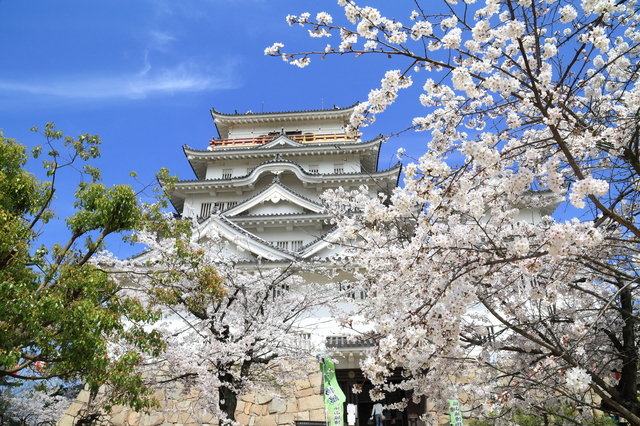
Fukuyama is in east Hiroshima, about 30 minutes away by bullet from the city of Hiroshima. The best area for hanami here is Fukuyamajo Park, which spreads around Fukuyama Castle. The castle was finished in 1622 and was rebuilt in 1966. This area is a popular hanami spot, with about 500 trees including Yoshino, mountain, and satozakura cherry trees surrounding the castle with the colors of spring.
During the season, the trees are lit up from sundown to 10:00 pm. While Fukuyamajo Park is nice during regular hours, it's exquisite during sakura season. It's easily accessible from the station, so you won't have to travel too far to see the sight of a Japanese castle towering among the cherry blossoms.
Peak cherry blossom season: Late March to early April
About Fukuyamajo Park
Closed: Never
Price: Free
Access: A short walk from Fukuyama Station
Address: Marunouchi 1, Fukuyama-shi, Hiroshima (Google Map)
Website (English): visithiroshima.net/things_to_do/attractions/historical_places/fukuyama_castle.html
Website (Traditional Chinese): tw.visithiroshima.net/things_to_do/attractions/historical_places/Fukuyama_castle.html
Website (Japanese): www.kankou.pref.hiroshima.jp/sys/data?page-id=5416
8. Miyajima, Hatsukaichi
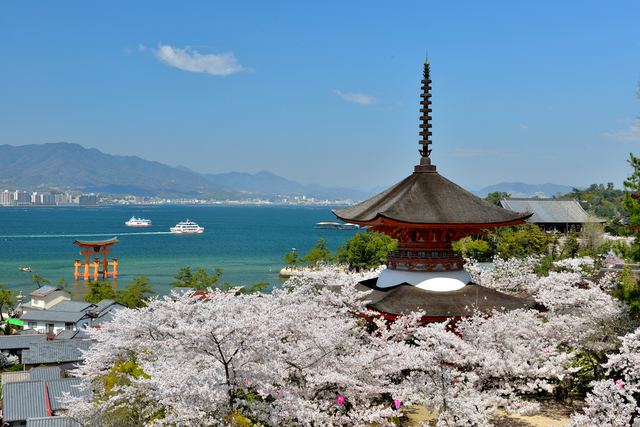
Miyajima, also known as Itsukushima, a World Heritage Site famous for its "floating" torii gate. It's full of people year round, but it's especially beautiful during sakura season. There are about 1,900 trees on the island, so it becomes one big hanami spot where you can enjoy a pink atmosphere full of Japanese beauty. Pictured is teh view of the Tahoto pagoda. This is a great photo spot with the sakura, Itsukushima Jinja, and the big torii gate floating in the blue sea just below.
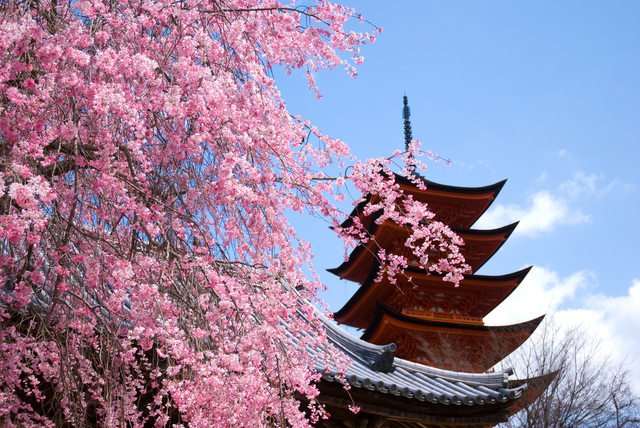
Sakura bloom near the five story pagoda as well, creating a beautiful combination. There's also the Uguisu Road, a natural path, and Omoto Park. Omoto Park is a little walk, but it's not very crowded, so you can enjoy the blossoms in peace!
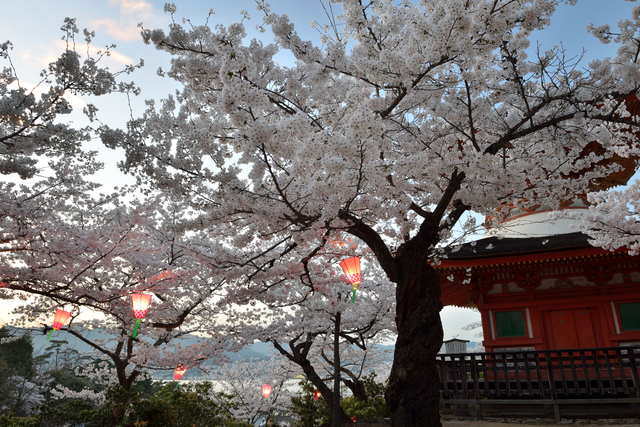
The path to Itsukushima Jinja is lit up by lanterns at night, creating a charming sight. Itsukushima Jinja, the five story pagoda, and the torii gate are all illuminated in the evenings as wel. There are fewer people on the island at night, giving you a more peaceful experience than the often crowded daytime. If you can, stay overnight on Miyajima and enjoy the views of the island during spring at night, early morning, and dusk. If you can't stay the night, keep in mind that the island takes a little time to reach by ferry. If you have the time, plan for a day trip. To learn more about all there is to do at this World Heritage site, check out our article rouding up, 15 Things To Do Around Miyajima, Hiroshima.
Peak cherry blossom season: Late March to early April
About Miyajima
Opening hours: 24 hours
Closed: Never
Price: Free
Access: 10 minute ferry from Miyajimaguchi Pier
Address: Miyajima-cho, Hatsukaichi-shi, Hiroshima (Google Map)
Website (English): visit-miyajima-japan.com/en/
Website (Traditional Chinese): visit-miyajima-japan.com/zht/
Website (Japanese): www.miyajima-wch.jp/
9. Senkoji Park, Onomichi
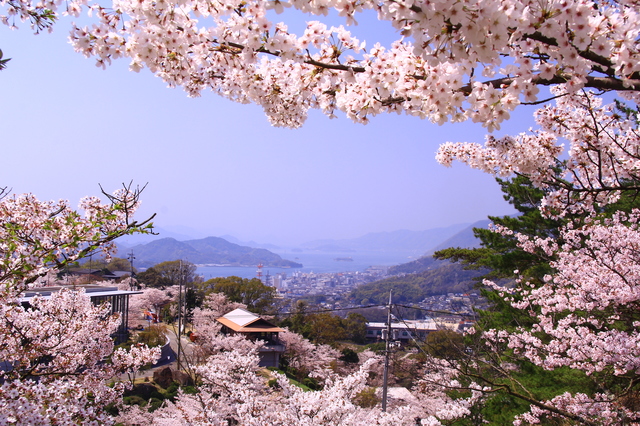 PIXTA
PIXTA
Onomichi is sandwiched between Mihara and Fukuyama, and is a famous sightseeing area with a traditional townscape. It's about 30 minutes from the city of Hiroshima via bullet train. Senkoji Park is on the summit of Mt. Senkoji, which has an elevation of 144 metres, and is a popular hanami spot that's considered one of Japan's top 100 cherry blossom spots. The view from the observation point is impressive. You can see all of Onomichi, as well as the beauty of islands spotting the Seto Inland Sea.
About 1,500 Yoshino and double-flowered cherry trees bloom here. During the peak period, they're lit up with lanterns between 6:00 pm and 12:00 am, and with lights until 6:00 am, giving you plenty of time to take in the atmosphere.
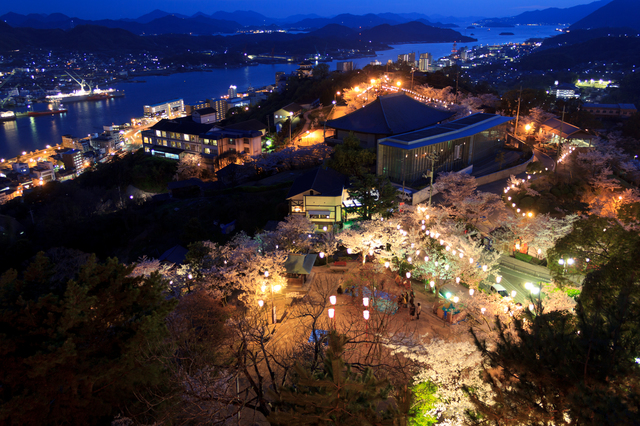
PIXTA
The entirety of the park is lit up by paper lanterns. You can enjoy an even more beautiful, romantic time here at night. It's great for people that want to enjoy the sight of sakura in the evening.
Peak cherry blossom season: Late March to early April
About Senkoji Park
Opening hours: 24 hours
Closed: Never
Price: Free
Access: A 15 minute walk from Onomichi Station, followed by a 3 minute ride on the ropeway from Senkoji Ropeway Sanroku Station
Address: 19 -1 Nishitsuchido-cho, Onomichi-shi, Hiroshima (Google Map)
Website (Japanese): www.ononavi.jp/sightseeing/showplace/detail.html?detail_id=322
10. Sera Kouzan Fureai no Sato, Sera
Sera is almost in the center of Hiroshima, southeast of the city. It takes about 2 hours to get there from the city of Hiroshima, but the weeping cherry-lined road in the Sera Kouzan Fureai no Sato is one of the country's leading hanami spots. There are also Yoshino and double-flowered cherry trees here, but the weeping cherry trees are a must-see. The gorgeous sight of their drifting branches makes for a perfect leisurely walk.
During the season they hold the Sakura Matsuri festival where you can buy bento meals or souvenirs and have lunch by the trees. It's also lit up in the evenings during the season. It takes a little while to reach the area, and you have to switch trains a few times, but it's a great spot if you like heading off the beaten track. It's also perfect for anyone who particularly likes weeping sakura trees.
Peak cherry blossom season: Mid to late April
About Sera Kouzan Fureai no Sato
Opening hours: 9:00 am - 5:00 pm
Closed: Never
Price: Adults 800 yen, Children 400 yen
Access: 10 minute taxi ride from Kawasa Station
Address: 1049 Otani, Sera-cho, Sera-gun, Hiroshima (Google Map)
Website (Japanese): www.kouzan-f.com/
11. Ondo no Seto Park, Kure
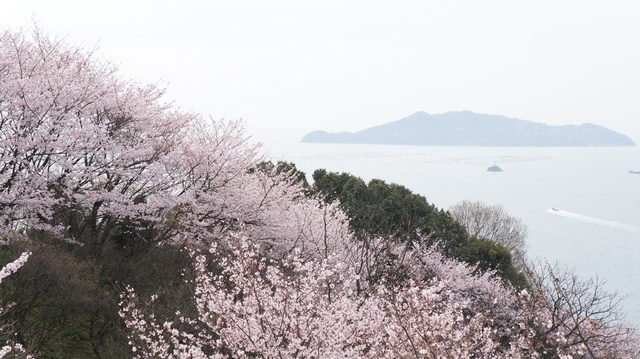
PIXTA
Kure is in the southeastern part of the prefecture, only about 30 minutes via express train from the city of Hiroshima. Recommended here is Ondo no Seto Park, a park that sits between the two bridges of Ondo Ohashi and Daini Ondo Ohashi. This location means you can see a view of the Ondo no Seto strait between the mainland and Kurahashi Island. From the Takanari observation point, you can enjoy the sight of the Akinada Sea and various islands framed by sakura trees.
The sight of the bright red bridges and the sakura make for a wonderful sight. There's a facility in the park called the Sakura no Sato with about 1,100 trees from five varieties to enjoy. From late April to early May about 5,300 azaleas are also in bloom here.
Peak cherry blossom season: Late March to early April
About Ondo no Seto Park
Opening hours: 24 hours
Closed: Never
Price: Free
Access: 30 minute bus ride from Kure Station, alight at Ondo Ohashi-shita bus stop
Address: 8 Kegoya, Kure-shi, Hiroshima (Google Map)
Website (Japanese): www.hiroshima-kankou.com/spot/3830
12. Yachiyo Lake (Haji Dam), Akitakata
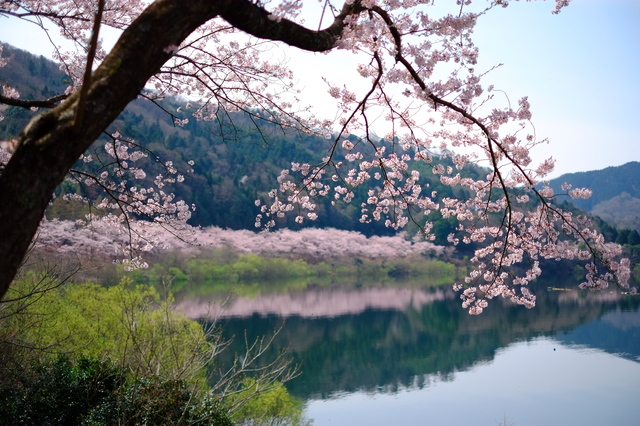
PIXTA
Akitakata is in the northern part of the prefecture, and takes a little less than an hour to reach from the city of Hiroshima. It's an area surrounded by nature, and best spot for hanami is Hachiyo Lake, or Haji Dam. There are around 6,000 trees around the lake, making it one of the leading spots in the prefecture. There's also a 3.7 km bike path available where visitors can enjoy cycling on rental bikes beneath the sakura.
If you like to ride, you can also head to the prefectural roads that have pedestrian paths to cycle the 20 km perimeter of the park. During the sakura season, Nodokoe Park in the northeastern part of the lake sets up around 400 sakura lanterns, so don't forget to check that out. However, since it's difficult to reach the lake by bus or train, this area is best for people who can rent a car.
Peak cherry blossom season: Late March to early April
About Hachiyo Lake
Opening hours: 24 hours
Closed: Never
Price: Free
Access: 10 km down prefectural road 5 towards Haji from the Chiyoda interchange (parking available; free on weekdays, 500 yen per car on Saturdays and Sundays)
Address: Haji, Yachiyo-cho, Akitakata-shi, Hiroshima (Google Map)
Website (Japanese): www.atlas-21.co.jp/cycling.html
Conclusion
All of these hanami spots offer beautiful sakura in a range of settings, including some that can only be found in Hiroshima. These sights are only available once a year, so more the reason to check them out if you visit Hiroshima during the spring season. If you're visiting Hiroshima in a different season, not to worry! This area is beautiful year round. For more information, check out our comprehensive guide to the area, 25 Things to Do in Hiroshima.
If you're visiting Japan in cherry blossom season, we're here to help! Our 2020 Cherry Blossom Forecast covers all you need to know about the best places in Japan to see cherry blossoms, plus exactly when they're forecasted to be at their peak in 2020. Cherry blossom season is short, so visit our guide to really enjoy this beautiful time of year!
If you want to give feedback on any of our articles, you have an idea that you'd really like to see come to life, or you just have a question on Japan, hit us up on our Facebook, Twitter, or Instagram!
The information in this article is accurate at the time of publication.























